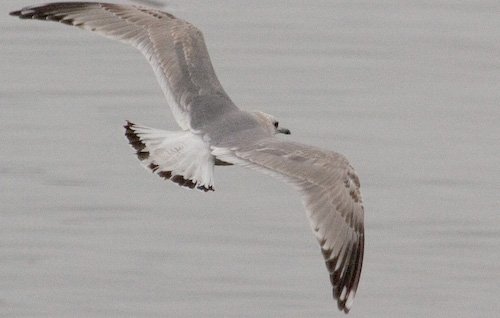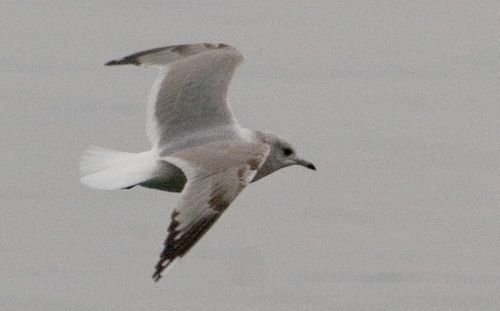

Among the gulls at Sage Beach today were two birds that look to me like second year Mew Gulls. One of them had black on its tail he other had a pure white tail. I noticed in Sibley’s that the European population of the Mew Gull has second year birds with white tail feathers, while the American form is shown with black on the tail feathers. However, Sibley’s also indicates that the Common Mew Gulls that have been reported in Alaska are from the Siberian population, but there is not a picture of that form. Are there any gull experts out there that might be able to help me with this? Do the short-billed (American) population birds sometimes have all white tail feathers?
Hi Matt – just a quick note – yes, 2nd-winter Mew Gulls can show quite a variable tail pattern – most show a moderate amount of black on the tail – a very few may show what looks like a complete tail band (like the bird in the upper photo nearly shows), while, conversely, a few may show a completely white tail like your bird. The older the gull (prior to full adult plumage) he more variable their plumage characters can be. For example, larger pink-footed gulls in their 3rd-winter show the most variability in their plumage, from birds that look nearly like adults, to birds that look nearly like 2nd-winter birds.
(Also, while I don’t know of any well-documented Kamtchatka Mew Gull records on the Pacific coast of North America, it is certainly a possibility – that race is larger with longer legs and a longer and thicker bill (doesn’t look as pigeon-headed) slightly darker mantled, and more black in the outer primaries.)
Steve Heinl
Just did a fast look thru your site. I enjoyed it, expecially the pictures. We got our first Cckling goose just the other day so it was great to see your picture of both.
Plan and Hope to cruise your way this summer. Till then, keep birding!